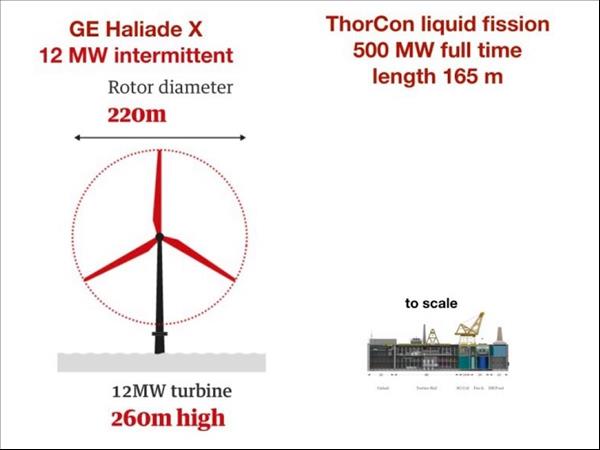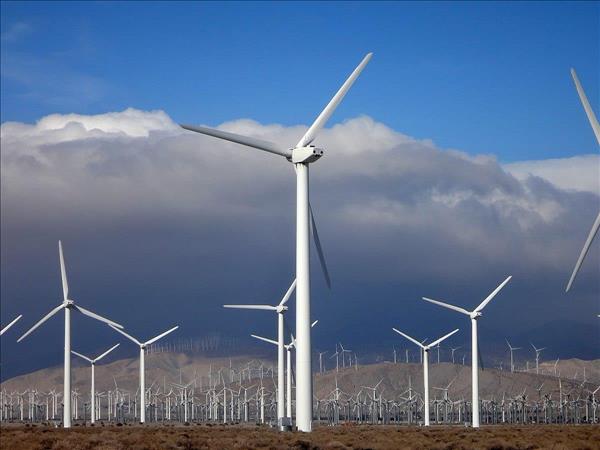(MENAFN- Asia Times) This is Part 5 of the series Watch Out! Biden wants to save the planet. Click to read Part 1 , Part 2 , Part 3 and Part 4 .
US President Joe Biden has made fighting global warming a top priority in all spheres of government activity and vows to make the US electric power system 100% carbon dioxide-free by 2035. He has not, however, spelled out how the administration intends to achieve this goal. The choice of technology plays a key role.
Many climate activists – but by no means all – are pushing for a plan based exclusively on so-called renewable energy sources, particularly wind and solar power, without any use of nuclear energy. But without nuclear energy, Biden's green effort will be doomed to disaster.
The only available alternative to large-scale nuclear power would be to scale up wind and solar energy to cover 80% or more of total electricity generation. Other sources, such as hydroelectric power, geothermal, biomass (with replanting), could hardly be expected to cover more than about 20% of total US consumption.
A vast infrastructure would be needed to support such a heavy reliance upon wind and solar, which are intermittent, land- and resource-intensive energy sources. That includes restructuring the whole US electricity grid and creating gigantic amounts of electricity storage capacity.
If the magnitude of financial and physical resources that would need to be invested are taken into account, it is clear that this scenario will never be carried through to the end.
Instead of the promised nirvana of 100% renewable energy, the overhaul would inevitably end in chaos with exploding electricity costs, frequent blackouts, rationing of electricity consumption and repressive measures to cut energy consumption. Many power plants would most likely still be burning fossil fuels, as the country would not be able to get along without them.
Long before that, a powerful political backlash would likely have swept the Democratic Party out of power – along with anyone else identified with the plan. So what is so problematic about the '100% renewable' scenario?
First: the output of wind turbines and solar cells fluctuates over a wide range on time-scales of minutes, depending on weather conditions. Solar cell output varies depending on cloud cover and time of day, being zero at night.
Due to the erratic variations in wind strength, the average output of an onshore wind turbine is generally only about a third of its maximum rated capacity (the figure is about 38% for an offshore turbine). About 2000 typical-size 1.5 megawatt wind turbines are needed to generate as much average electric power as a standard one-gigawatt nuclear power plant. Unlike wind turbines, nuclear plants generate a constant, controllable flow of electricity.

To obtain a dependable supply based on wind and solar, supplementary electricity sources are needed to step in when their output drops. That costs money. In most present-day practice – where fossil fuels have not yet been banned – this is done mainly with the help of auxiliary gas turbines, diesel generators or – when nuclear plants are available – by 'load-following' that constantly adjusts nuclear plant outputs. Load-following can work as long as the ratio of nuclear to wind-plus-solar is large enough.
Otherwise, the only alternative is to import electricity from somewhere else, assuming it is available when you need it, or to store part of the output of wind and solar sources and inject stored electricity back into the grid when their output falls. The most-cited option is to use batteries – a lot of them.

Source: Wikimedia
The second basic problem is the low power density of wind and solar energy. Aside from hurricanes and tornadoes, wind is a diffuse form of energy that requires large areas to 'harvest' it. The same applies to sunlight on the surface of the Earth.
Compared to nuclear plants or state-of-the-art fossil fuel plants, wind and solar require hundreds of times as many individual units, hundreds of times more land area and tens of times larger amounts of steel, concrete and other materials to produce a given average power output.
The figure below illustrates what low power density means: a 260-meter tall 12 MW GE Haliade X offshore wind turbine, compared with the size of a nuclear power plant – in this case an advanced-generation reactor being developed by the ThorCon company for Indonesia.

Source: Thorcon
GE's Heliade X is two-thirds the height of the Empire State Building, or half the height of the former World Trade Center! But for a nominal rating of 12 megawatts, we will be lucky to get 5 MW average output – a hundredth of the output of the 'tiny' nuclear power plant at the right.
That's similar for land use. Michael Shellenberger, a staunch environmentalist who has become an outspoken advocate of nuclear energy, compared the land area required for a given level of power production by typical nuclear plants, wind farms and solar parks in various countries.
For example, the nuclear plant in Borsella, Netherlands, occupies about .16 square kilometers of land and produces 3.46 billion kilowatt-hours of electricity per year, while Holland's Gemini Offshore Wind Farm occupies 68 square kilometers and produces 2.6 billion kilowatt-hours. The nuclear plant produces 570 times more power per unit area than the wind farm – and 370 times more than the solar park Sunport Delfzijl.
In South Korea the factor was 625 times for nuclear versus onshore wind and 468 times for nuclear versus solar. Figures in the nine other countries examined are analogous.
Note also that wind turbines degrade the quality of life of people unfortunate enough to live in the vicinity. Ironically, irrational environmentalism has caused an unprecedented scale of destruction of the natural landscape.
This has given a new meaning to the term blowback. In Germany, the resistance of local populations has brought the expansion of wind energy to a standstill. Large solar parks are not popular, either.

Wind turbines in southern California. Photo: Wikimedia
There is no question that wind and solar power are mature technologies, that have an important role to play as complementary energy sources in specific contexts. But as far as the economics of large-scale use is concerned, the lobby of commercial interests linked to wind and solar energy – which is now much larger than the nuclear lobby ever was – has done everything possible to pull the wool over the eyes of the public.
We are constantly told that the cost of wind and solar energy has dropped dramatically and that they are already the cheapest power sources.
Common sense, and the electricity prices in California, Germany, and Denmark – which have all gone big on renewable energy – tell a different story, as do many independent studies. See for example the detailed study by Gordon Hughes of the University of Edinburgh, 'Wind Power Economics – Rhetoric & Reality .'
The real costs of wind and solar are obscured by subsidized prices, renewable energy credits, production tax credits, green bond discounts, accelerated depreciation, property tax exemptions and tax credits.
Competing fossil fuel sources are 'punished' by imposing carbon taxes and by giving first preference to renewables in the purchase of electricity by network providers. (See Chapter 3 of the excellent book Electrifying Our World , by ThorCon co-founder Robert Hargraves.)
The real costs of wind and solar energy also include the investments needed to integrate them into a national power system that must reliably meet demand. A 100% renewable energy scenario means transforming a vast electrical system that was designed to operate on the basis of stable fossil fuel and (later) nuclear energy sources.

A field of solar panels in Devon, England, UK. Photo: wiki.jpg
During the Windpower 2019 conference, Dan Shreve, head of global analysis at Wood Mackenzie Power and Renewables, stated that achieving 100% renewable energy would require doubling the length of the high-voltage electric transmission lines in the US.
That means putting up over 320,000 kilometers of new transmission lines. In addition, the US would need huge amounts of additional electricity storage capacity. How much electricity would have to be stored in batteries and other storage systems to make sure the lights don't go out when it gets dark and the wind drops off ?
This is a complicated question, but it is worth citing a couple of crude estimates.
Willem Post, a former engineer and frequent writer on energy issues, addresses this issue : 'According to weather data, the US has multi-day, wind/solar lulls covering at least 25% of the land area. They occur at random times throughout the year. A lull is defined at 15% of normal electricity output for that time of year.'
Estimating how much electricity would have to be supplied by storage systems in order to make up for missing wind and solar output during such a one-day lull, he comes up with 67 billion kilowatt-hours.
For comparison, the battery of a Tesla model S electric car can store about 85 kilowatt-hours. Dividing that into his estimate, we get the equivalent of 788 million fully-charged Tesla S batteries.

A Tesla Model S battery – long, thin and flat – occupies the base of the chassis. Photo: Wikimedia Commons
Tesla founder Elon Musk has promised that battery storage costs will come down to $100 per kilowatt-hour – a 30% improvement from today. The price-tag would then be $6.7 trillion for the first full set of batteries. Let's hope they will not have to be replaced too often.
Results of a much more elaborate study were reported last year in the engineering magazine Bridge. The authors utilized data for the hourly electricity load and weather conditions in the seven New England states of the US during 2018, scaling up wind and solar capacities to match the annual energy consumption. The study takes into account the entire regime of operation of the system of sources and storage, which shows strong seasonal variations.
The authors come up with an estimate of 14 billion kilowatt-hours for the amount of electricity storage capacity that would be needed to ensure a reliable supply for New England in a '100% wind and solar' scenario. If we scale this estimate up to the whole US – whose electricity consumption is 35 times larger – we get the terrifying figure of 490 billion kilowatt-hours.
Assuming all-battery storage at the optimistic price of $100 per kWh, the price-tag would be $49 trillion!
The actual amount of storage capacity required would presumably be much less than this extrapolation suggests. Among other things, climate and weather conditions differ greatly among US regions.
In addition, building 320,000 kilometers of new transmission lines, as mentioned above, would allow electricity to be constantly shipped back and forth all across the country, according to the weather and time of day.
But whatever the millions or billions of batteries will cost, the very prospect of a nation basing its entire energy security on intermittent, weather- and climate-dependent power sources ought to frighten any sane person.
Meanwhile, some climate activists such David McDermott Hughes have come up with a much cheaper and quicker solution: Abandon the traditional goal of providing a reliable energy supply to meet the demands of society. Instead, require the population to adapt its consumption to the available supply.
Under this prescription the US population should simply come to accept rationing and power interruptions, of the sort that are unfortunately still common in underdeveloped countries. That would be the necessary price for averting the climate apocalypse.
Caution: read this before the lights go out.
Jonathan Tennenbaum received his PhD in mathematics from the University of California in 1973 at age 22. Also a physicist, linguist and pianist, he is a former editor of FUSION magazine. He lives in Berlin and travels frequently to Asia and elsewhere, consulting on economics, science and technology.
MENAFN08032021000159011032ID1101714918